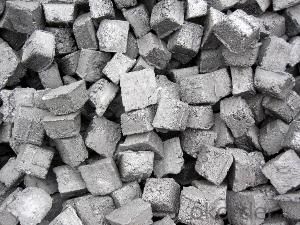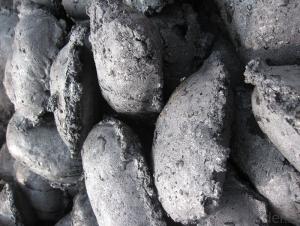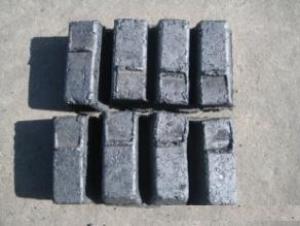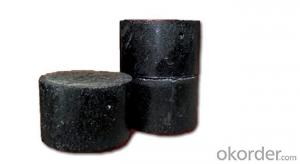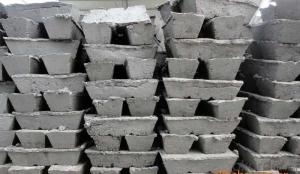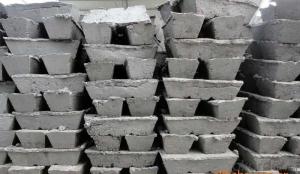High Quality Carbon Electrode Paste With Low Ash
- Loading Port:
- Lianyungang
- Payment Terms:
- TT OR LC
- Min Order Qty:
- 20 m.t.
- Supply Capability:
- 2000 m.t./month
OKorder Service Pledge
OKorder Financial Service
You Might Also Like
Spcifications
1:carbon eletrode paste
2:for ferroalloy,calcium carbide manufacture
3:HS 3801300000,YB/T5212-1996,ISO9001:2008
Product Description
Carbon Electrode Paste is a self-baking electrode used in submerged arc furnaces for delivering power to the charge mix. Electrode Paste is added to the top of the electrode column in either cylindrical or briquette form. As the paste moves down the electrode column the temperature increase causes the paste to melt and subsequently bake forming a block of electrically conductive carbon. Electrode Paste is essentially a mix of Electrically Calcined Anthracite (ECA) or Calcined Petroleum Coke (CPC) with Coal Tar Pitch.
Graphite/Carbon Electrode Paste
Specification/Item
Ash 4.0%max5.0%max 6.0%max7.0% Max9.0% Max11.0% Max
VM 12.0%-15.5%12.0%-15.5%12.0%-15.5%9.5.0%-13.5%11.5%-15.5%11.5%-15.5%
Strength
Compress 18.0Mpa Min17.0Mpa Min15.7Mpa Min19.6Mpa Min19.6Mpa Min19.6Mpa Min
Specific 65μΩm Max68μΩm Max75μΩm Max80μΩm Max90μΩm Max90μΩm Max
Resistance
Bulk Density1.38G/CM3 Min1.38G/CM3 Min1.38G/CM3 Min1.38G/CM3 Min1.38G/CM3 Min1.38G/CM3 Min
Picure:

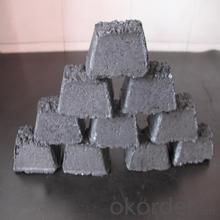


- Q: How is carbon used in the production of plastics?
- Plastics heavily rely on carbon, an indispensable ingredient, for their manufacturing. These polymers consist of extensive chains formed by repeating units, known as monomers. These monomers, in turn, consist of smaller molecules. Carbon atoms constitute a vital element in these monomers, serving as the foundation for the polymer chain. To acquire carbon for plastic production, diverse petroleum products, like crude oil and natural gas, are sourced. These fossil fuels contain hydrocarbons, which are organic compounds comprised of carbon and hydrogen atoms. Through a refining process called cracking, hydrocarbons are broken down into smaller molecules, including ethylene and propylene, which serve as the basic building blocks for numerous plastic types. Once these monomers are acquired, they are polymerized, meaning they are chemically bonded together to create lengthy chains. Carbon atoms play a critical role in this procedure, as they connect to shape the backbone structure of the polymer chain. The specific arrangement and bonding of carbon atoms dictate the properties of the resulting plastic, including its strength, flexibility, and durability. It is worth noting that while carbon is crucial, not all plastics are exclusively composed of this element. Other elements, such as oxygen, nitrogen, and chlorine, may be present in the monomers or introduced during production to enhance specific properties or introduce desired functionalities. All in all, carbon serves as a fundamental element in plastic production. It establishes the backbone structure, enabling the versatility and wide array of applications of plastic materials across various industries.
- Q: What are the potential uses of carbon nanomaterials in medicine?
- Due to their distinctive properties, carbon nanomaterials hold great promise in the field of medicine. One area where they could be utilized is in drug delivery systems. The efficient loading and release of therapeutic agents, made possible by their high surface area-to-volume ratio, enables targeted and controlled drug delivery. As a result, more effective treatments with fewer side effects can be achieved. Another potential application of carbon nanomaterials is in medical imaging. Carbon nanotubes and graphene, among others, possess excellent optical and electrical properties that can enhance imaging techniques like MRI and CT scans. This enhancement could result in improved accuracy and resolution, leading to better disease diagnosis and monitoring. Moreover, carbon nanomaterials exhibit antibacterial properties that can be harnessed for wound healing and infection control. They can effectively eliminate bacteria and prevent the formation of biofilms, which are often resistant to traditional antibiotics. This has the potential to revolutionize infection treatment, particularly for bacteria that have become resistant to antibiotics. Additionally, carbon nanomaterials hold promise in tissue engineering and regenerative medicine. Their biocompatibility, mechanical strength, and electrical conductivity make them suitable for creating scaffolds that support tissue growth and promote regeneration. They can also enhance the electrical stimulation of tissues, aiding in nerve regeneration and improving the functionality of artificial organs. Furthermore, carbon nanomaterials have been investigated for their ability to detect and monitor diseases at an early stage. Their unique electronic and optical properties can be leveraged in biosensors and diagnostic devices, enabling sensitive and specific detection of disease-associated biomarkers. While the potential applications of carbon nanomaterials in medicine are extensive, it is important to emphasize that further research and development are necessary to ensure their safety, efficacy, and long-term effects. Regulatory considerations and ethical concerns surrounding the use of nanomaterials in medicine also need to be addressed. Nevertheless, the promising capabilities of carbon nanomaterials offer hope for the future of advanced and personalized medical treatments.
- Q: We need to make a poster... Of the 27 essential elements of the human body, I am in charge of carbon! I haven't found it for a long time! Who can help me? Urgent!!!!!!Can you find something very specific? Thank you
- It can be said that without carbon, there would be no life. Carbon is Dongliangzhicai the world of life.
- Q: What are the challenges of carbon capture and storage technology?
- Carbon capture and storage (CCS) technology shows promise as a solution for reducing greenhouse gas emissions and combating climate change. Nevertheless, there are various obstacles that must be overcome in order for it to be widely adopted and effective. One of the primary hurdles associated with CCS technology is its considerable cost. The implementation of CCS necessitates significant investments in infrastructure, equipment, and operations, making it economically burdensome. Additionally, the capture process itself requires substantial amounts of energy, resulting in increased costs and potentially limiting its feasibility. Another challenge pertains to the limited capacity for storage. Identifying suitable underground sites for storing the captured carbon dioxide (CO2) is crucial, but can be difficult due to geological limitations. The task of identifying and evaluating suitable sites with adequate storage capacity is complex and necessitates meticulous planning. Furthermore, concerns exist regarding the long-term stability and integrity of the storage sites. Leakage of stored CO2 could compromise the effectiveness of CCS and pose environmental risks. Ensuring the secure and safe storage of captured carbon is essential to prevent any adverse impacts on ecosystems and public health. Transporting the captured CO2 from the capture sites to the storage facilities also presents a challenge. Establishing an efficient and extensive transportation infrastructure is necessary for the widespread implementation of CCS technology. Developing pipelines or other means of transportation capable of handling the volume of captured CO2 and ensuring its secure transport over long distances is crucial. Public acceptance and social factors also significantly impact the challenges associated with CCS technology. Local communities may have concerns and objections regarding potential risks associated with the capture, transport, and storage of CO2. Effectively addressing these concerns through transparent communication and engagement with stakeholders is vital for garnering public support and minimizing opposition. In conclusion, carbon capture and storage technology has the potential to greatly reduce greenhouse gas emissions. However, its challenges, including high costs, limited storage capacity, integrity concerns, transportation infrastructure, and public acceptance, must be addressed to ensure successful implementation and make a significant contribution to mitigating climate change.
- Q: How does carbon impact the prevalence of tropical storms?
- Carbon, specifically in the form of carbon dioxide (CO2) emissions, plays a significant role in impacting the prevalence of tropical storms. The increase in atmospheric CO2 levels due to human activities such as burning fossil fuels, deforestation, and industrial processes has led to the phenomenon known as global warming. This rise in global temperatures has several implications for the formation and intensity of tropical storms. Firstly, warmer temperatures cause an increase in the evaporation of seawater, resulting in higher levels of moisture in the atmosphere. Moisture is a crucial factor in the development of tropical storms, as it provides the necessary fuel for their formation and sustenance. With more moisture available, the potential for tropical storms to develop and strengthen is enhanced. Additionally, rising global temperatures lead to the expansion of the warm tropical oceans, providing a larger area for tropical storms to form and intensify. This expansion allows for a greater exchange of energy between the ocean and the atmosphere, further enhancing the potential for storm development. Furthermore, elevated levels of CO2 contribute to ocean acidification, which has detrimental effects on marine ecosystems, including coral reefs. Coral reefs act as natural barriers that protect coastal areas from storm surges and waves generated by tropical storms. However, the acidification of oceans weakens and destroys these reefs, leaving coastal regions more vulnerable to the impacts of storms. Lastly, climate change caused by carbon emissions alters atmospheric and oceanic circulation patterns, which can affect the movement and tracks of tropical storms. Changes in wind patterns and ocean currents may cause storms to deviate from their traditional paths, leading to increased uncertainty and potential impacts on regions that are not typically prone to these events. In summary, carbon emissions and the subsequent global warming they cause have significant impacts on the prevalence of tropical storms. Increased moisture content, expanded warm ocean areas, weakened coastal defenses, and altered storm tracks are all consequences of rising carbon levels, which ultimately contribute to more frequent and intense tropical storms.
- Q: Carbon emissions trading stocks latest list of carbon emissions trading stocks what?
- Carbon trading concept of a total of 21 listed companies, of which 12 carbon trading concept listed companies trading on the Shanghai Stock Exchange, and 9 other carbon trading concept listed companies trading in the Shenzhen stock exchange.Automatic matching based on the cloud financial leading excavator, carbon trading stocks leading shares most likely from the following stock was born in Tianke, electrical, environmental protection up to confidence.
- Q: What are the impacts of carbon emissions on indigenous communities?
- Indigenous communities are greatly affected by carbon emissions, which have significant impacts on their environment, culture, health, and overall well-being. One of the main consequences is the degradation of their traditional lands and natural resources, which are crucial for their livelihoods, including hunting, fishing, and agriculture. The increase in carbon emissions leads to climate change, resulting in changes in temperature, weather patterns, and ecosystems. This disrupts the delicate balance of their ecosystems and makes it more challenging for them to sustain their way of life. The loss of traditional lands and resources also has profound cultural implications for indigenous communities. Their connection to the land is deeply rooted in their identity and spirituality. When their lands are degraded or destroyed due to carbon emissions, it erodes their cultural practices, knowledge, and traditions. This loss of cultural heritage affects not only indigenous communities but also the global society, as their unique knowledge about sustainable land management and conservation practices can offer valuable insights for addressing climate change and protecting the planet. Moreover, carbon emissions contribute to air pollution, which severely impacts the health of indigenous communities. Many indigenous communities live near industrial facilities or fossil fuel extraction sites, leading to increased exposure to pollutants such as particulate matter, sulfur dioxide, and nitrogen oxides. These pollutants cause respiratory illnesses, cardiovascular diseases, and other health issues, disproportionately affecting vulnerable members of these communities, including children and the elderly. In addition to immediate health impacts, the long-term consequences of carbon emissions, such as rising sea levels and extreme weather events, pose further threats to the existence of indigenous communities. Many indigenous communities reside in low-lying coastal areas or remote regions that are more susceptible to the effects of climate change, including coastal erosion, flooding, and loss of traditional food sources. These changes not only disrupt their way of life but also force them to consider relocation, resulting in the loss of their cultural identity and connection to their ancestral lands. Addressing carbon emissions and mitigating climate change is crucial for the well-being and survival of indigenous communities. It involves recognizing their rights to their traditional lands, resources, and self-determination, as well as involving them in decision-making processes regarding environmental conservation. Supporting sustainable development projects that prioritize local needs and indigenous knowledge can help foster resilient communities that can adapt to the changing climate. Ultimately, by reducing carbon emissions and protecting the environment, we can preserve the cultural diversity and invaluable contributions of indigenous communities for future generations.
- Q: Who can explain that bare feet on fire carbon don't burn feet?
- The fire is red carbon, but no signs of fire and water after scald. Actually, that's a very simple physical phenomenon. The most mysterious matter where we can buy, can make the carbon fire red instantly cool, people ran fast, naturally not hurt hair.These two substances, one is white borax, and the other is red cinnabar (also known as cinnabar). It turns out that the crystals are dissolved because they absorb large amounts of heat. When borax or cinnabar scattered on the surface of carbon fire, because the heat will make the wood surface temperature drop.
- Q: How does carbon affect the formation of hurricanes?
- Hurricane formation is not directly affected by carbon. It is primarily driven by warm ocean temperatures, high humidity, and the Coriolis effect. However, carbon emissions and the resulting increase in greenhouse gases have been linked to climate change, which indirectly affects the formation and intensity of hurricanes. The accumulation of carbon dioxide and other greenhouse gases in the atmosphere is causing climate change, which is leading to higher global temperatures. These warmer ocean temperatures provide more energy to hurricanes, potentially increasing their intensity and destructiveness. Furthermore, climate change can alter wind patterns and atmospheric circulation, influencing the development and movement of hurricanes. Moreover, when carbon dioxide dissolves into seawater, it can cause ocean acidification. This can harm marine life and disrupt the delicate balance of ecosystems. Such disruption can indirectly impact hurricane formation, as healthy ecosystems play a crucial role in regulating the climate and maintaining a stable environment. While the formation of hurricanes is not directly impacted by carbon emissions, their contribution to climate change and subsequent effects on Earth's systems can have significant consequences for the frequency, intensity, and behavior of hurricanes. To lessen the future impacts of hurricanes and protect vulnerable coastal regions, it is important to reduce carbon emissions and mitigate climate change.
- Q: What are the economic impacts of carbon emissions?
- The economic impacts of carbon emissions are significant and wide-ranging. Carbon emissions, primarily from the burning of fossil fuels, contribute to climate change and global warming. These changes in the climate have a direct impact on various economic sectors and can lead to both short-term and long-term economic consequences. One of the most notable economic impacts of carbon emissions is the cost of dealing with the effects of climate change. Extreme weather events, such as hurricanes, floods, and droughts, become more frequent and intense as a result of carbon emissions. These events can cause extensive damage to infrastructure, homes, and businesses, leading to significant economic losses. For example, in 2017, the United States experienced a record-breaking hurricane season, with hurricanes Harvey, Irma, and Maria causing an estimated $265 billion in damages. Moreover, carbon emissions also affect agricultural productivity. Climate change alters temperature and precipitation patterns, which can disrupt crop production and decrease yields. This, in turn, affects food prices and availability, impacting both consumers and farmers. Additionally, carbon emissions contribute to the acidification of oceans, which can harm marine ecosystems and disrupt fisheries, leading to economic losses for fishing communities. Furthermore, carbon emissions have implications for public health, which can result in economic burdens. Air pollution caused by carbon emissions can lead to respiratory and cardiovascular illnesses, increasing healthcare costs and reducing workforce productivity. In addition, extreme heatwaves, exacerbated by carbon emissions, can have a detrimental impact on worker productivity and labor capacity, affecting economic output. To mitigate the economic impacts of carbon emissions, many countries have implemented policies and regulations to reduce greenhouse gas emissions. These policies often include carbon pricing mechanisms, such as carbon taxes or cap-and-trade systems, which aim to incentivize the transition to cleaner energy sources and reduce carbon emissions. While these policies may have short-term economic costs, they can also create opportunities for innovation and the development of green technologies, which can lead to long-term economic benefits. In conclusion, the economic impacts of carbon emissions are significant and multifaceted. From the costs of dealing with climate-related disasters to the effects on agriculture, public health, and productivity, carbon emissions have far-reaching consequences. Addressing these impacts through the implementation of effective climate policies is crucial to mitigate the economic risks and foster a sustainable and resilient economy.
Send your message to us
High Quality Carbon Electrode Paste With Low Ash
- Loading Port:
- Lianyungang
- Payment Terms:
- TT OR LC
- Min Order Qty:
- 20 m.t.
- Supply Capability:
- 2000 m.t./month
OKorder Service Pledge
OKorder Financial Service
Similar products
Hot products
Hot Searches





